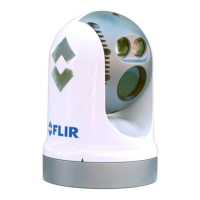Electrical Connections
432-0012-01-12 Version 110 15
Connecting Power
The camera itself does not have an on/off switch. Generally the camera will be connected to a
circuit breaker and the circuit breaker will be used to apply or remove power to the camera. When
power is supplied, the camera will be in one of three modes: Booting Up, Standby, Parked, or
Powered On. The M500 Operator’s Manual has detailed information about powering and operating
the camera.
Installation of a circuit breaker (or fuse) in line with the power connection is required to protect the
power wiring and camera from power surge or short circuit.
The installer must use power cable wires that are sufficient size gauge or diameter for the supply
voltage and total load (camera and length of cable run), to ensure proper supply voltage at the
camera and adequate current carrying capacity.
Warning: Use of insufficient wire gauge can result in fire. Wire gauge depends on supply voltage
shown. For lower supply voltages, lower gauge wire must be used.
Proper Grounding
Caution: Ensure the camera is properly grounded. Following best grounding practices, the
camera chassis ground should use the lowest resistance path possible.
Failure to provide this connection may result in electrical interference between camera and other
shipboard electronic systems. Furthermore, it is recommended that a bonded grounding scheme
is used with a common ground between the chassis ground and electrical return, with the
connection made as close as possible to the negative terminal of the battery.
Video Connections
Video cables of various lengths with different connectors at one end are available from FLIR. The
video cable used should be rated as RG6 to ensure an adequate quality video signal. For cable
runs in excess of 100 ft, a video amplifier should be used.
Ethernet Connections
The Ethernet cable from the camera can be connected to another Ethernet cable with an RJ45
waterproof enclosure connector (FLIR PN 4115028). The Ethernet network cable should be
8-conductor T568B, Ethernet, double-shielded for EMI considerations.
TABLE 1.3 Fuse Recommendation
Model Fuse
M500 12 amp, slow blow at lowest voltage range (12 Vdc)
TABLE 1 4. Typical Power Cable Wire Gauge
Length in Meters
(Feet)
Wire Gauge (AWG)
for 12V Supply
Wire Gauge (AWG)
for 24V Supply
8 (25) 16 18
16 (50) 14 18
24 (75) 12 16
32 (100) 10 16

